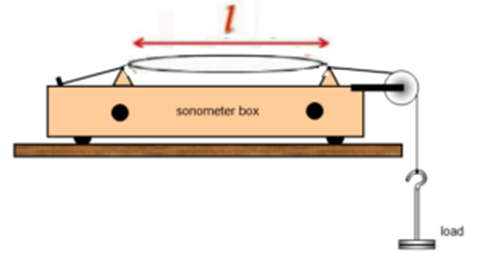Science > Physics > Stationary Waves > Sonometer Experiment
In this article, we shall study construction and working of sonometer, and its use to verify the laws of string.
Laws of Vibrating String:
Law of Length:
If the tension in the string and its mass per unit length of wire remains constant, then the frequency of transverse vibration of a stretched string is inversely proportional to the vibrating length.
Law of Tension:
If the vibrating length and mass per unit length of wire remain constant then, the frequency of transverse vibration of a stretched string is directly proportional to the square root of the tension in the string.
Law of Mass:
If the vibrating length and tension in the string remain constant then, the frequency of transverse vibration of a stretched string is inversely proportional to the square root of its mass per unit length
Sonometer:
Construction:
A sonometer consists of a hollow rectangular wooden box to which a uniform wire is attached at one end. The other end of the wire is passed over two horizontal knife edges or bridges and then over a pulley. A weight hanger is suspended from the free end of the wire. By placing different weights in the weight hanger, the tension in the wire can be suitably adjusted.

The points at which the wire rests on the knife edges cannot vibrate at all. Hence, when the wire is set up into vibrations, these two points become nodes and the wire vibrates in the fundamental mode. The frequency of vibration of the wire can be varied by either changing the positions of the knife edges by changing the vibrating length or by placing different weights in the pan by changing the tension.
Use of Sonometer to Determine the Unknown Frequency of a Tuning Fork:
To determine the unknown frequency of a tuning fork, the tension T in the wire is kept constant and the vibrating length between the knife edges is so adjusted, that the fundamental frequency of the wire becomes the same as that of the fork. To test this a small paper rider is placed on the wire midway between the knife edges where an antinode is formed.
The fork is set up into vibration and its stem is placed on the wooden box. The length of the wire is adjusted till it vibrates in unison with the fork. When this happens, the centre of the vibrating wire vibrates with maximum amplitude due to resonance, and the paper rider is thrown off. Then the frequency of the tuning fork which is the same as the fundamental frequency of the wire is given by

Where ‘m’ is the mass per unit length of the wire. The frequency of the fork is determined, knowing l, T, and m.
Use of Sonometer to Verify the Law of Length:
If the tension in the string and its mass per unit length of wire remains constant, then the frequency of transverse vibration of a stretched string is inversely proportional to the vibrating length.
To verify , the given wire (m = constant) is kept under constant tension (T = constant). A set of tuning forks having different frequencies n1, n2, n3, n4, etc. is taken. The length of the wire, vibrating in unison with each fork, is determined in turn using a paper rider or hearing beats. Let the lengths corresponding to the frequencies be l1, l2, l3, l4, etc.
Then, it is found that, within the limits of experimental error, n1l1 = n2l2 = n3l3 = n4l4 = constant. Thus in general n l = constant or n ∝ 1/l. If a graph of n against 1/l is plotted, it comes out as a straight line.
Use of Sonometer to Verify the Law of Tension:
If the vibrating length and mass per unit length of wire remain constant then, the frequency of transverse vibration of a stretched string is directly proportional to the square root of the tension in the string. To verify the law, the vibrating length of the given wire and linear density ‘m’ is constant. A set of tuning forks having different frequencies n1, n2, n3, n4 etc. is taken.
By adjusting the tension T, each fork is made to vibrate in unison with the fixed length of the wire, one after the other. Let the tensions corresponding to the frequencies n1, n2, n3, n4, etc. be T1, T2, T3, T4, etc. respectively. Then it is found that, within limits of experimental error.

A graph of n² against T comes out as a straight line.
Use of Sonometer to Verify the Law of Mass:
If the vibrating length and tension in the string remain constant then, the frequency of transverse vibration of a stretched string is inversely proportional to the square root of its mass per unit length. This law cannot be verified directly, as either ‘n’ nor ‘m’ can be varied continuously as in the case of l or T. Therefore, this law is verified indirectly as follows. The relation can be written as

Then, to verify the law, we must show that when n and T are kept constant. A number of wires having linear densities m1, m2, m3, m4, etc. are taken. Each one of them is subjected to the same tension T. Then, using a given tuning fork (n = constant) each wire is made to vibrate in unison with the fork, by adjusting its length. Let l1, l2, l3, l4, etc. be the vibrating length corresponding to linear densities m1, m2, m3, m4, etc. respectively.
Then it is found that, within the limits of experimental error.

Hence the law is indirectly verified.
Previous Topic: Vibrations of String
Next Topic: Melde’s Experiment
2 replies on “Sonometer Experiment”
Excellent explaination it is.
Thank you so much ♥️